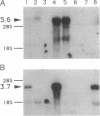Abstract
Glutamic acid decarboxylase (GAD; glutamate decarboxylase, L-glutamate 1-carboxy-lyase, EC 4.1.1.15), which catalyzes formation of gamma-aminobutyric acid from L-glutamic acid, is detectable in different isoforms with distinct electrophoretic and kinetic characteristics. GAD has also been implicated as an autoantigen in the vastly differing autoimmune disease stiff-man syndrome and insulin-dependent diabetes mellitus. Despite the differing GAD isoforms, only one type of GAD cDNA (GAD-1), localized to a syntenic region of chromosome 2, has been isolated from rat, mouse, and cat. Using sequence information from GAD-1 to screen a human pancreatic islet cDNA library, we describe the isolation of an additional GAD cDNA (GAD-2), which was mapped to the short arm of human chromosome 10. Genomic Southern blotting with GAD-2 demonstrated a hybridization pattern different from that detected by GAD-1. GAD-2 recognizes a 5.6-kilobase transcript in both islets and brain, in contrast to GAD-1, which detects a 3.7-kilobase transcript in brain only. The deduced 585-amino acid sequence coded for by GAD-2 shows less than 65% identity to previously published, highly conserved GAD-1 brain sequences, which show greater than 96% deduced amino acid sequence homology among the three species. The function of this additional islet GAD isoform and its importance as an autoantigen in insulin-dependent diabetes remain to be determined.
Full text
PDF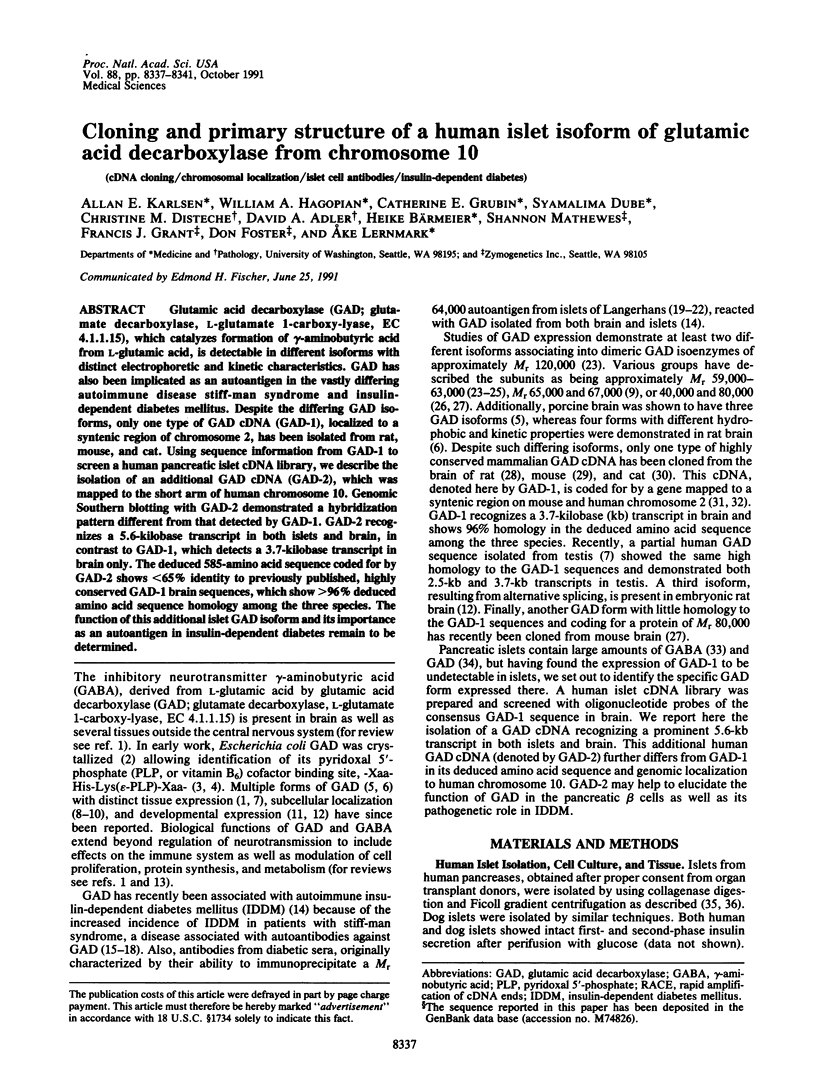
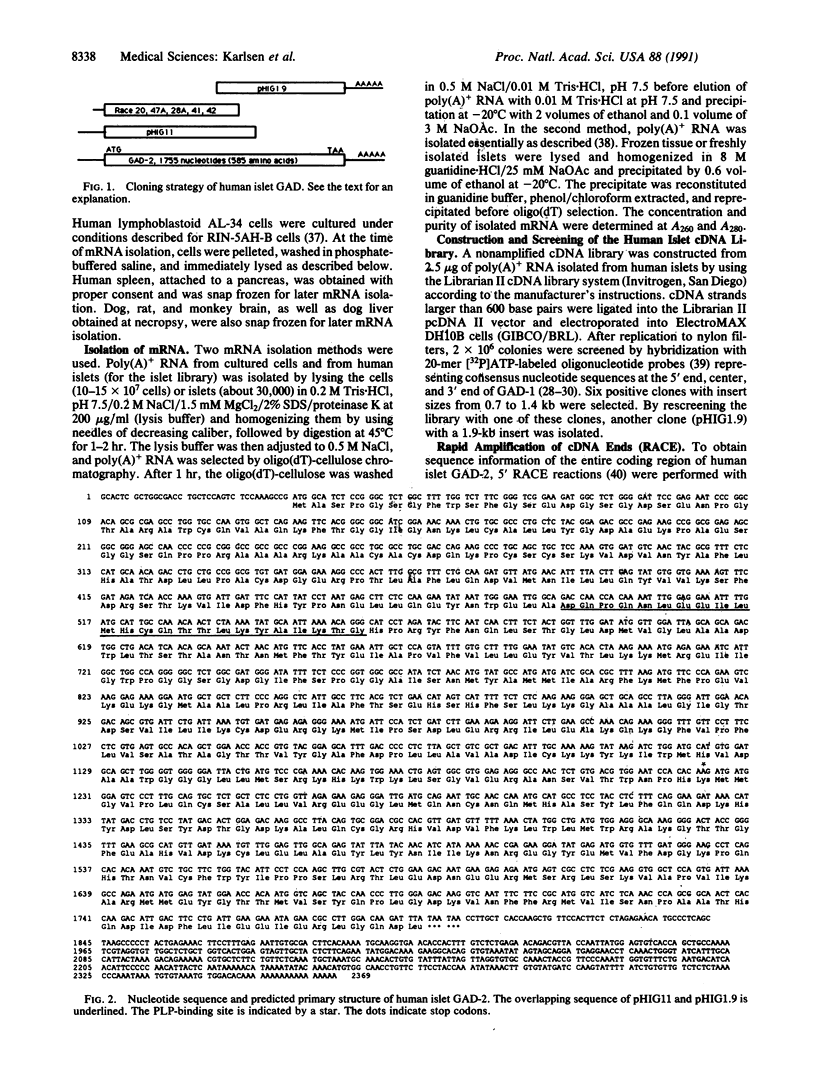
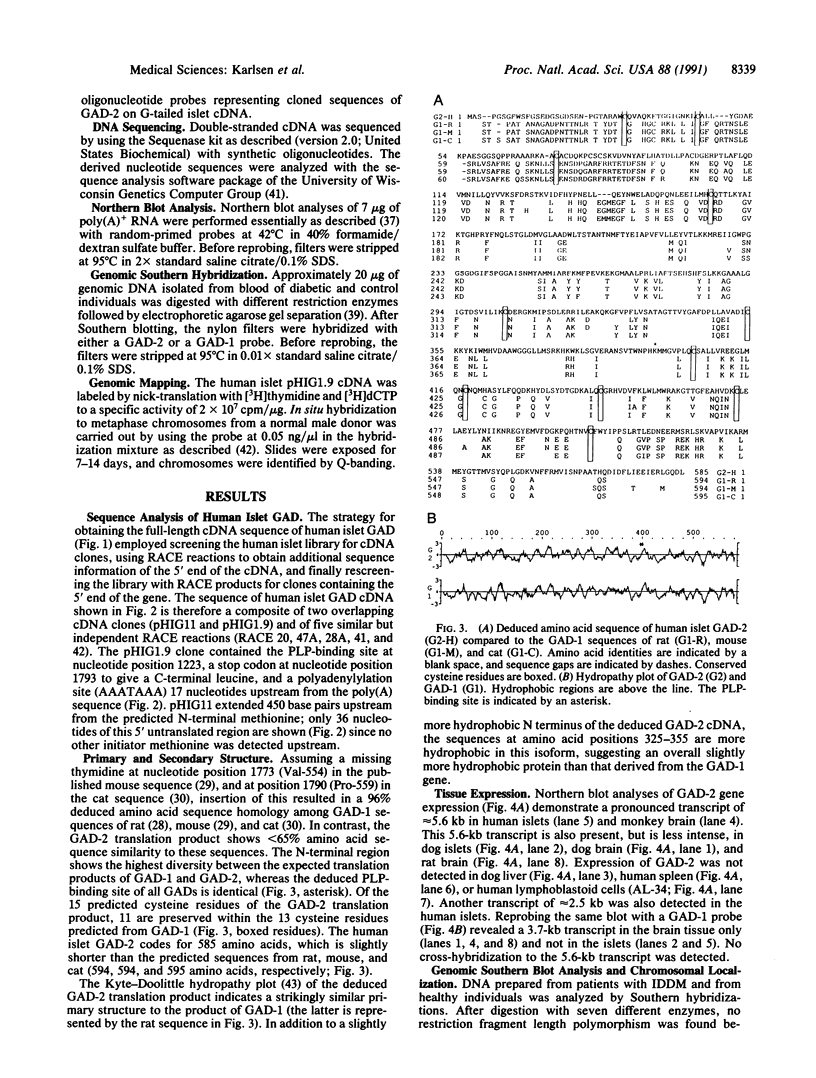
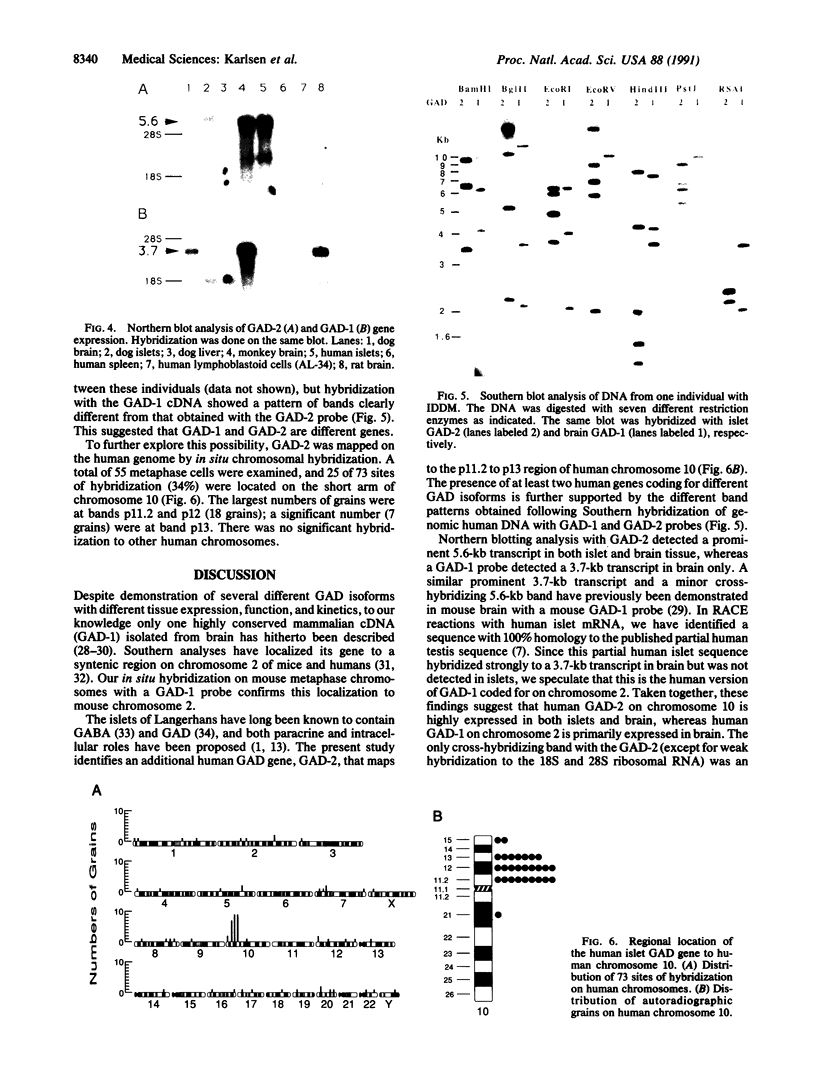
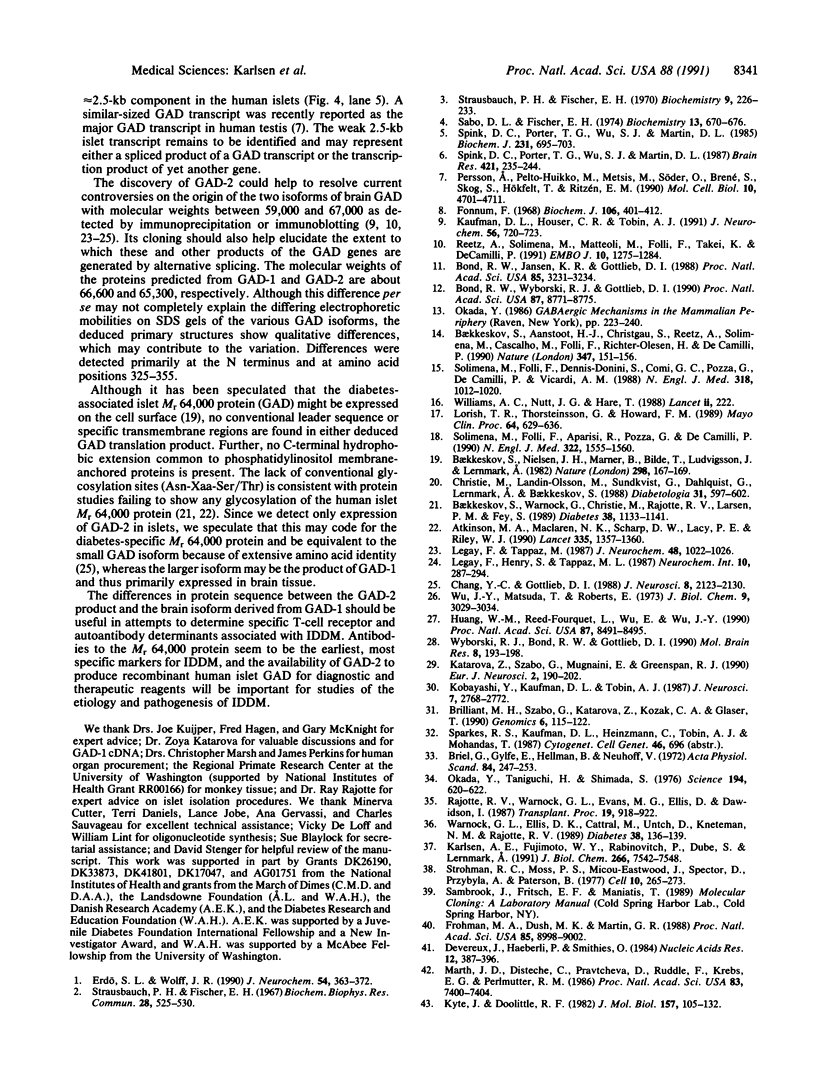
Images in this article
Selected References
These references are in PubMed. This may not be the complete list of references from this article.
- Atkinson M. A., Maclaren N. K., Scharp D. W., Lacy P. E., Riley W. J. 64,000 Mr autoantibodies as predictors of insulin-dependent diabetes. Lancet. 1990 Jun 9;335(8702):1357–1360. doi: 10.1016/0140-6736(90)91241-2. [DOI] [PubMed] [Google Scholar]
- Baekkeskov S., Aanstoot H. J., Christgau S., Reetz A., Solimena M., Cascalho M., Folli F., Richter-Olesen H., De Camilli P., Camilli P. D. Identification of the 64K autoantigen in insulin-dependent diabetes as the GABA-synthesizing enzyme glutamic acid decarboxylase. Nature. 1990 Sep 13;347(6289):151–156. doi: 10.1038/347151a0. [DOI] [PubMed] [Google Scholar]
- Baekkeskov S., Nielsen J. H., Marner B., Bilde T., Ludvigsson J., Lernmark A. Autoantibodies in newly diagnosed diabetic children immunoprecipitate human pancreatic islet cell proteins. Nature. 1982 Jul 8;298(5870):167–169. doi: 10.1038/298167a0. [DOI] [PubMed] [Google Scholar]
- Baekkeskov S., Warnock G., Christie M., Rajotte R. V., Larsen P. M., Fey S. Revelation of specificity of 64K autoantibodies in IDDM serums by high-resolution 2-D gel electrophoresis. Unambiguous identification of 64K target antigen. Diabetes. 1989 Sep;38(9):1133–1141. doi: 10.2337/diab.38.9.1133. [DOI] [PubMed] [Google Scholar]
- Bond R. W., Jansen K. R., Gottlieb D. I. Pattern of expression of glutamic acid decarboxylase mRNA in the developing rat brain. Proc Natl Acad Sci U S A. 1988 May;85(9):3231–3234. doi: 10.1073/pnas.85.9.3231. [DOI] [PMC free article] [PubMed] [Google Scholar]
- Bond R. W., Wyborski R. J., Gottlieb D. I. Developmentally regulated expression of an exon containing a stop codon in the gene for glutamic acid decarboxylase. Proc Natl Acad Sci U S A. 1990 Nov;87(22):8771–8775. doi: 10.1073/pnas.87.22.8771. [DOI] [PMC free article] [PubMed] [Google Scholar]
- Briel G., Gylfe E., Hellman B., Neuhoff V. Microdetermination of free amino acids in pancreatic islets isolated from obese-hyperglycemic mice. Acta Physiol Scand. 1972 Feb;84(2):247–253. doi: 10.1111/j.1748-1716.1972.tb05175.x. [DOI] [PubMed] [Google Scholar]
- Brilliant M. H., Szabo G., Katarova Z., Kozak C. A., Glaser T. M., Greenspan R. J., Housman D. E. Sequences homologous to glutamic acid decarboxylase cDNA are present on mouse chromosomes 2 and 10. Genomics. 1990 Jan;6(1):115–122. doi: 10.1016/0888-7543(90)90455-4. [DOI] [PubMed] [Google Scholar]
- Chang Y. C., Gottlieb D. I. Characterization of the proteins purified with monoclonal antibodies to glutamic acid decarboxylase. J Neurosci. 1988 Jun;8(6):2123–2130. doi: 10.1523/JNEUROSCI.08-06-02123.1988. [DOI] [PMC free article] [PubMed] [Google Scholar]
- Christie M., Landin-Olsson M., Sundkvist G., Dahlquist G., Lernmark A., Baekkeskov S. Antibodies to a Mr-64,000 islet cell protein in Swedish children with newly diagnosed type 1 (insulin-dependent) diabetes. Diabetologia. 1988 Aug;31(8):597–602. doi: 10.1007/BF00264766. [DOI] [PubMed] [Google Scholar]
- Devereux J., Haeberli P., Smithies O. A comprehensive set of sequence analysis programs for the VAX. Nucleic Acids Res. 1984 Jan 11;12(1 Pt 1):387–395. doi: 10.1093/nar/12.1part1.387. [DOI] [PMC free article] [PubMed] [Google Scholar]
- Erdö S. L., Wolff J. R. gamma-Aminobutyric acid outside the mammalian brain. J Neurochem. 1990 Feb;54(2):363–372. doi: 10.1111/j.1471-4159.1990.tb01882.x. [DOI] [PubMed] [Google Scholar]
- Fonnum F. The distribution of glutamate decarboxylase and aspartate transaminase in subcellular fractions of rat and guinea-pig brain. Biochem J. 1968 Jan;106(2):401–412. doi: 10.1042/bj1060401. [DOI] [PMC free article] [PubMed] [Google Scholar]
- Frohman M. A., Dush M. K., Martin G. R. Rapid production of full-length cDNAs from rare transcripts: amplification using a single gene-specific oligonucleotide primer. Proc Natl Acad Sci U S A. 1988 Dec;85(23):8998–9002. doi: 10.1073/pnas.85.23.8998. [DOI] [PMC free article] [PubMed] [Google Scholar]
- Huang W. M., Reed-Fourquet L., Wu E., Wu J. Y. Molecular cloning and amino acid sequence of brain L-glutamate decarboxylase. Proc Natl Acad Sci U S A. 1990 Nov;87(21):8491–8495. doi: 10.1073/pnas.87.21.8491. [DOI] [PMC free article] [PubMed] [Google Scholar]
- Karlsen A. E., Fujimoto W. Y., Rabinovitch P., Dube S., Lernmark A. Effects of sodium butyrate on proliferation-dependent insulin gene expression and insulin release in glucose-sensitive RIN-5AH cells. J Biol Chem. 1991 Apr 25;266(12):7542–7548. [PubMed] [Google Scholar]
- Katarova Z., Szabo G., Mugnaini E., Greenspan R. J. Molecular Identification of the 62 kd Form of Glutamic Acid Decarboxylase from the Mouse. Eur J Neurosci. 1990;2(3):190–202. doi: 10.1111/j.1460-9568.1990.tb00412.x. [DOI] [PubMed] [Google Scholar]
- Kaufman D. L., Houser C. R., Tobin A. J. Two forms of the gamma-aminobutyric acid synthetic enzyme glutamate decarboxylase have distinct intraneuronal distributions and cofactor interactions. J Neurochem. 1991 Feb;56(2):720–723. doi: 10.1111/j.1471-4159.1991.tb08211.x. [DOI] [PMC free article] [PubMed] [Google Scholar]
- Kobayashi Y., Kaufman D. L., Tobin A. J. Glutamic acid decarboxylase cDNA: nucleotide sequence encoding an enzymatically active fusion protein. J Neurosci. 1987 Sep;7(9):2768–2772. doi: 10.1523/JNEUROSCI.07-09-02768.1987. [DOI] [PMC free article] [PubMed] [Google Scholar]
- Kyte J., Doolittle R. F. A simple method for displaying the hydropathic character of a protein. J Mol Biol. 1982 May 5;157(1):105–132. doi: 10.1016/0022-2836(82)90515-0. [DOI] [PubMed] [Google Scholar]
- Legay F., Henry S., Tappaz M. Evidence for two distinct forms of native glutamic acid decarboxylase in rat brain soluble extract: an immunoblotting study. J Neurochem. 1987 Apr;48(4):1022–1026. doi: 10.1111/j.1471-4159.1987.tb05620.x. [DOI] [PubMed] [Google Scholar]
- Lorish T. R., Thorsteinsson G., Howard F. M., Jr Stiff-man syndrome updated. Mayo Clin Proc. 1989 Jun;64(6):629–636. doi: 10.1016/s0025-6196(12)65339-7. [DOI] [PubMed] [Google Scholar]
- Marth J. D., Disteche C., Pravtcheva D., Ruddle F., Krebs E. G., Perlmutter R. M. Localization of a lymphocyte-specific protein tyrosine kinase gene (lck) at a site of frequent chromosomal abnormalities in human lymphomas. Proc Natl Acad Sci U S A. 1986 Oct;83(19):7400–7404. doi: 10.1073/pnas.83.19.7400. [DOI] [PMC free article] [PubMed] [Google Scholar]
- Okada Y., Taniguchi H., Schimada C. High concentration of GABA and high glutamate decarboxylase activity in rat pancreatic islets and human insulinoma. Science. 1976 Nov 5;194(4265):620–622. doi: 10.1126/science.185693. [DOI] [PubMed] [Google Scholar]
- Persson H., Pelto-Huikko M., Metsis M., Söder O., Brene S., Skog S., Hökfelt T., Ritzén E. M. Expression of the neurotransmitter-synthesizing enzyme glutamic acid decarboxylase in male germ cells. Mol Cell Biol. 1990 Sep;10(9):4701–4711. doi: 10.1128/mcb.10.9.4701. [DOI] [PMC free article] [PubMed] [Google Scholar]
- Rajotte R. V., Warnock G. L., Evans M. G., Ellis D., Dawidson I. Isolation of viable islets of Langerhans from collagenase-perfused canine and human pancreata. Transplant Proc. 1987 Feb;19(1 Pt 2):918–922. [PubMed] [Google Scholar]
- Reetz A., Solimena M., Matteoli M., Folli F., Takei K., De Camilli P. GABA and pancreatic beta-cells: colocalization of glutamic acid decarboxylase (GAD) and GABA with synaptic-like microvesicles suggests their role in GABA storage and secretion. EMBO J. 1991 May;10(5):1275–1284. doi: 10.1002/j.1460-2075.1991.tb08069.x. [DOI] [PMC free article] [PubMed] [Google Scholar]
- Sabo D. L., Fischer E. H. Chemical properties of Escherichia coli lysine decarboxylase including a segment of its pyridoxal 5'-phosphate binding site. Biochemistry. 1974 Feb 12;13(4):670–676. doi: 10.1021/bi00701a006. [DOI] [PubMed] [Google Scholar]
- Solimena M., Folli F., Aparisi R., Pozza G., De Camilli P. Autoantibodies to GABA-ergic neurons and pancreatic beta cells in stiff-man syndrome. N Engl J Med. 1990 May 31;322(22):1555–1560. doi: 10.1056/NEJM199005313222202. [DOI] [PubMed] [Google Scholar]
- Solimena M., Folli F., Denis-Donini S., Comi G. C., Pozza G., De Camilli P., Vicari A. M. Autoantibodies to glutamic acid decarboxylase in a patient with stiff-man syndrome, epilepsy, and type I diabetes mellitus. N Engl J Med. 1988 Apr 21;318(16):1012–1020. doi: 10.1056/NEJM198804213181602. [DOI] [PubMed] [Google Scholar]
- Spink D. C., Porter T. G., Wu S. J., Martin D. L. Characterization of three kinetically distinct forms of glutamate decarboxylase from pig brain. Biochem J. 1985 Nov 1;231(3):695–703. doi: 10.1042/bj2310695. [DOI] [PMC free article] [PubMed] [Google Scholar]
- Spink D. C., Porter T. G., Wu S. J., Martin D. L. Kinetically different, multiple forms of glutamate decarboxylase in rat brain. Brain Res. 1987 Sep 22;421(1-2):235–244. doi: 10.1016/0006-8993(87)91293-5. [DOI] [PubMed] [Google Scholar]
- Strausbauch P. H., Fischer E. H. Chemical and physical properties of Escherichia coli glutamate decarboxylase. Biochemistry. 1970 Jan 20;9(2):226–233. doi: 10.1021/bi00804a006. [DOI] [PubMed] [Google Scholar]
- Strausbauch P. H., Fischer E. H., Cunningham C., Hager L. P. Crystallization and properties of glutamate decarboxylase from Escherichia coli strain w+. Biochem Biophys Res Commun. 1967 Aug 23;28(4):525–530. doi: 10.1016/0006-291x(67)90345-2. [DOI] [PubMed] [Google Scholar]
- Strohman R. C., Moss P. S., Micou-Eastwood J., Spector D., Przybyla A., Paterson B. Messenger RNA for myosin polypeptides: isolation from single myogenic cell cultures. Cell. 1977 Feb;10(2):265–273. doi: 10.1016/0092-8674(77)90220-3. [DOI] [PubMed] [Google Scholar]
- Warnock G. L., Ellis D. K., Cattral M., Untch D., Kneteman N. M., Rajotte R. V. Viable purified islets of Langerhans from collagenase-perfused human pancreas. Diabetes. 1989 Jan;38 (Suppl 1):136–139. doi: 10.2337/diab.38.1.s136. [DOI] [PubMed] [Google Scholar]
- Williams A. C., Nutt J. G., Hare T. Autoimmunity in stiff man syndrome. Lancet. 1988 Jul 23;2(8604):222–222. doi: 10.1016/s0140-6736(88)92328-8. [DOI] [PubMed] [Google Scholar]
- Wu J. Y., Matsuda T., Roberts E. Purification and characterization of glutamate decarboxylase from mouse brain. J Biol Chem. 1973 May 10;248(9):3029–3034. [PubMed] [Google Scholar]
- Wyborski R. J., Bond R. W., Gottlieb D. I. Characterization of a cDNA coding for rat glutamic acid decarboxylase. Brain Res Mol Brain Res. 1990 Aug;8(3):193–198. doi: 10.1016/0169-328x(90)90016-7. [DOI] [PubMed] [Google Scholar]



